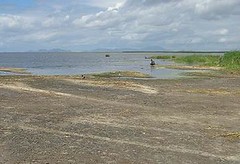 科學家提出警告,馬拉威的奇爾瓦湖(Lake Chilwa)恐將在2013年或2014年完全乾涸。而居住在湖邊捕魚或種田為生、超過一百萬人口恐將面臨飢荒及經濟崩潰。
科學家提出警告,馬拉威的奇爾瓦湖(Lake Chilwa)恐將在2013年或2014年完全乾涸。而居住在湖邊捕魚或種田為生、超過一百萬人口恐將面臨飢荒及經濟崩潰。
馬拉威糧食安全機構正高度關注奇爾瓦湖的枯竭。這個盆地是稻米種植區,且來自湖中的魚獲提供周邊鄉村許多馬拉威人蛋白質營養來源。
奇爾瓦湖長60公里、寬40公里,座落在馬拉威東邊,與莫三比克共和國接壤。周圍環繞著眾多拉薩姆公約所保護的重要溼地,奇爾瓦湖季節性會有來自北半球的候鳥棲息、繁殖及渡冬。
奇爾瓦湖的水位變化主要受到年降雨模式的影響。科學家們認為在馬欽加(Machinga)、法隆貝(Phalombe)及桑巴3個集水區日益嚴重的環境惡化,影響了降雨模式變動及湖面水位的變化。
目前乾涸預測是由馬拉威大學的大臣學院(Chancellor College)蒐集的降雨資料所推估的。
馬拉威世界魚類中心的資深科學家Daniel Jamu表示,2011-2012年的雨季,2011總降雨量為1048毫米、2012年到6月為655毫米。
目前有紀錄的類似降雨模式發生在1994-1995年的雨季,當時奇爾瓦湖完全枯竭。接下來2年的降雨量分別為775毫米及748毫米。
 在中斷了15年後,奇爾瓦湖流域氣候變遷適應計畫(LCBCCAP)2010年重新建立整個盆地湖水水位及河流排放監測。
在中斷了15年後,奇爾瓦湖流域氣候變遷適應計畫(LCBCCAP)2010年重新建立整個盆地湖水水位及河流排放監測。
LCBCCAP是個由挪威政府贊助,世界魚類中心、馬拉威林業研究機構、東非與南非環境發展領導組織(Lead)所共同執行的聯合計畫。
由社區及區域水辦公室共同進行的水位的觀察及監測結果,與大臣學院的雨量讀數吻合。
科學家們在本月稍早於大臣學院舉行的研討會中提出他們的警告。在命名為「如果奇爾瓦湖枯竭,我們是否準備好了?」議題下,院士、政治家、學生、領導人及自然資源管理技術專家共同討論對馬拉威的社會及經濟衝擊。
LEAD區域主管Sosten Chiotha教授同意大臣學院的雨量讀數,過去歷史資料呈現連續兩年低於1000毫米的降雨,的確導致該湖的完全乾涸。
過去歷史資料顯示,連續兩年低於1000毫米的降雨量,的確導致該湖的完全乾涸。
隸屬國際水產中心在多馬西(Domasi)漁業部門的Bruno Chirwa表示:「集水區環境加速惡化造成的淤積導致水位降低,這對整個水生生態系都是嚴重的威脅。」
Chirwa提出奇爾瓦湖的經濟產值每年超過2100萬美元,該湖魚獲量佔了馬拉威全國魚獲量的20%。
在卡丘盧港(Kachulu Harbour)水深僅剩2.1米。在某些地區湖水已幾近乾涸,擔心該湖可能會完全乾枯的恐懼正在上升。
奇爾瓦湖集水區八位傳統權威之一,來自Kuntumanji的代表表達了對湖水乾涸後將衝擊當地社區的經濟及營養的憂心。
長期研究奇爾瓦溼地的鳥類學家John Wilson回憶起1973年的溼地乾涸的景象:鯰魚躲在水塘、非洲鯽(tilapia fish)則必須沿著注入該湖的河流上溯以避難。
數位漁民表達對水位下降的憂心。Wilson呼籲當地社區管理一些池塘供魚類作為避難所。
然而,聯合國非洲千年村發展計畫馬拉威的主持人Andrew Daudi對於現況確有不同的見解。他說:「即使該湖乾涸,土地仍可作為種植穀物或開闢道路之用。一些會攻擊作物的蟲害將會隨著湖水乾涸而消失。」
他的言論招致大量持有不同觀點的人們回應,這些回應者認為該湖是當地區民的主要生計來源。
作為未來的展望,馬拉威政府環境部門的代理局長Aloysius Kamperewera告訴與會者:「是時候將90年代末期由丹麥政府資助規劃的奇爾瓦湖管理計畫付諸實行。」
Kamperewera所建議的方案包括雨水蒐集、建立管理機構,如此一來集水區內的農業發展將得以繼續。
Kamperewera表示,這樣一來,將第一優先保育奇爾瓦湖流域。
Malawi’s Lake Chilwa could dry up completely in 2013 or 2014, scientists warn. The prediction has created fears of hunger and economic ruin among the more than one million people in fishing and farming communities around the lake.
The drying of Lake Chilwa is a national food security concern. The basin is a rice growing area, and fish from the lake provide a source of nutritious protein to many rural Malawians.
Located on Malawi’s eastern border with Mozambique, Lake Chilwa is 60 kilometers long and 40 km wide (40 miles long by 25 wide).
Surrounded by extensive wetlands of international importance protected under the Ramsar Convention, the lake seasonally hosts migratory birds that fly from the Northern Hemisphere seeking to breed and escape winter’s harsh cold.
Lake Chilwa is driven by cyclic changes in water levels which are mainly influenced by annual rainfall patterns.
Scientists say the fluctuating rainfall patterns and changes in lake levels are influenced by accelerated environmental degradation taking place in the catchment area that spans three districts – Machinga, Phalombe and Zomba.
The current drying forecast is based on rainfall readings collected by the weather station at Chancellor College, the main constituent college of the University of Malawi.
During the 2011-2012 season, the total rainfall recorded was 1048 millimeters (41.2 inches) in 2011 and 655mm (25.7 inches) through June 2012, says Daniel Jamu, a senior scientist at Malawi’s World Fish Centre.
Similar rainfall patterns were recorded in the 1994-1995 season when the lake lost all its water. The total annual rainfall recorded then for the two consecutive years was 775 millimeters (30 inches) and 748mm (29.4 inches).
The Lake Chilwa Basin Climate Change Adaptation Programme, LCBCCAP, re-established lake level and river discharge monitoring in the basin in 2010 after a 15-year break.
LCBCCAP is a joint program funded by the government of Norway and executed by the World Fish Centre, the Forestry Research Institute of Malawi and the think tank Leadership for Environment and Development in Southern and Eastern Africa, LEAD.
Lake level observations and monitoring are conducted by communities in collaboration with district water offices. These measurements corroborate the Chancellor College rainfall readings.
Scientists made their warnings public during a seminar held earlier this month at Chancellor College. Academicians, politicians, students, chiefs and technocrats in natural resources management discussed the social and economic implications for the nation under the theme, “If Lake Chilwa dries up, are we prepared?”
Professor Sosten Chiotha, LEAD regional director, agreed with Dr. Jamu that the rainfall readings collected at Chancellor College meteorological station, plus the history of a rainfall pattern lower than 1000mm for two consecutive years, has resulted in the complete drying of the lake in the past.
Bruno Chirwa of the National Aquaculture Centre’s fisheries department unit at Domasi said, “Accelerated environmental degradation in the catchment area is causing siltation leading to reduction in the lake level. This is a major threat to the aquatic ecosystem.”
Chirwa said Lake Chilwa’s economic values exceed US$21 million annually and that lake contributes 20 percent of all the fish caught in Malawi.
At Kachulu Harbour the lake level gauge has already dropped below 2.1 meters (82.6 inches). In some areas the gauge is very close to the bottom of the lake, increasing fears that the lake is likely to dry up.
A representative of the Traditional Authority of Kuntumanji, one of eight traditional authorities in the Lake Chilwa catchment basin, expressed worry that the predicted drying will cause economic and nutritional hardship for local communities.
John Wilson, an ornithologist who has long studied birds in the Chilwa wetland, recalled how when the wetland dried in 1973, catfish had to take refuge in water pools, while tilapia fish had to migrate upstream to rivers that flow into the lake.
Several fishermen expressed worry about the decreasing water levels. Wilson urged local communities to take control of the management of the pools so that fish can seek shelter there.
However, Andrew Daudi, head of the United Nations Millennium Villages Project in Malawi, had a different take on the situation. “Even if the lake dries the land could be put to good use through farming and and road construction. Certain insects that attack crops would disappear once that lake dries up,” he said.
His comments attracted a host of reactions from people with dissenting views who said the lake is of great importance to the livelihoods of local people.
As a way forward, Aloysius Kamperewera, acting director of the Malawi government’s Environmental Affairs Department, told participants, “It is high time that the Lake Chilwa management plan that was hatched during the Danish-funded project in the late 1990s be put into action now.”
Kamperewera suggested exploring avenues such as rainwater harvesting and developing a management authority so that agricultural development projects taking place in the catchment area would adhere to the plan.
In this way, Kamperewera said, conservation of the Lake Chilwa watershed could become a priority.
※ 全文及圖片詳見 ENS




